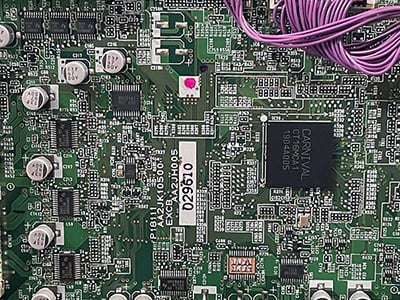How The Global Chip Shortage Is Affecting Office Copier & MFP Deliveries (2 Solutions)
Office Copiers, Printers, and MFPs | Print
While we’re all about to enter 2022, there are still effects of the pandemic that are affecting us globally. For one, the supply-chain crisis results from COVID-19 related disruptions coupled with a sudden boom in demand for products of all shapes and sizes.
Unfortunately, the current shortages of equipment, workers, and space aren’t just affecting your personal orders but your work orders for office copier equipment as well.
As an office copier and MFP provider, our team at LDI understands how frustrating it can be not to receive your printing equipment on time, especially when your business requires it for its daily operations. That’s why our team of specialists like to offer proactive solutions to help mitigate any inconvenience you may be facing in the meantime.
This article will explain how and why your MFP’s and office technology deliveries are delayed. We provide you with the understanding you need to know what to do with your orders from here on out. We will also cover a few creative solutions that your business can consider while waiting for an MFP delivery.
How And Why Is Your MFP Delivery Delayed?
Suppose your organization has purchased or leased a new multifunction printer (MFP) in the past month or two. In that case, you’re probably still waiting for it right now.
If you haven’t noticed, there’s quite a backorder problem when purchasing or leasing new printing devices for your organization.
If you think you’re alone in this – trust us, you’re not. Unfortunately, everyone is experiencing the same issue with their office technology and even personal orders.
To be precise, there are two specific reasons why your office copier, printer, or MFP may be delayed. One being the chip shortage and the second being shipping constraints.
While some brands don’t face both issues per se, chip shortages and shipping constraints are affecting the industry at large.
For example, Sharp’s parent company manufactures chips. Therefore, attaining chips for their devices to function isn’t an issue like it is for other manufacturers.
It all depends on the manufacturer.
Let’s go ahead and break it down even further:
Chip Shortage
Think of a microchip processor as a compact unit of packaged computer circuitry. A microchip is responsible for creating an electrical signal that can provide electrical instructions to a device to turn on and function.

Essentially chips are required for technical equipment to work.
Are you with us so far?
Now, Taiwan is responsible for 63% of all microchip processors manufactured globally. After Taiwan, South Korea is responsible for roughly 18% of microchip production, next to China’s 6%. Together, Asia produces 87% of all microchips used across the globe.
Like most businesses across the world were forced to cut down on having employees working at the office, microchip factories were forced to reduce their production operations.
In turn, this has caused a hefty backlog of orders.
Since the pandemic, the demand for microchips has skyrocketed, which has required chip factories to produce more products with fewer workers and resources, making the need impossible to fulfill.
Alas, leading us to this supply-chain backup we’re all now in.
Shipping Constraints & Supply-Chain Backups
With Taiwan’s ports also working with reduced workers, there has also been a cut back in global shipping.

While the demand for shipping has dramatically increased and has surpassed pre-pandemic levels, global shipping has been cut back dramatically since the very beginning of the pandemic.
To compensate for the reduced number of ships, containers have been stacked higher and higher, which has equated to dockers spending a more extended amount of time unloading each ship.
Unfortunately, the supply-chain backup has had a ripple effect on retailers forced to delay products. So, no matter what brand of MFP your business purchased or leased, whether that be Xerox, Canon, HP, Sharp, Konica Minolta — every manufacturer faces these same delays.
While these delays are predicted to lessen by sometime in 2022, no one knows for sure with the delta variant on the rise.
2 Proactive Solutions Your Business Can Implement Right Now
Let’s get right down to it – what can your business do right now?
While there isn’t much you can do if your order has already been placed, you can stay proactive and think creatively.
Let’s break down two proactive solutions your organization can implement.
1. Build A Strong Relationship With Your Independent Dealer
If your organization doesn’t already have a strong relationship with the independent dealer or managed print provider who sold you your new office copier or MFP, now is the time to connect with them and reach out.
Your partnership with your MFP dealer should be one you can depend on.
Why?
Well, any good independent dealer or managed print provider wants to make sure that you feel confident about your buying or leasing decision even after it has been made. Any struggle getting in the way of your business operations should feel as vital to them as it does to you.
Learn what options you have in the meantime and ask them how they can accommodate you during this frustrating time and in the future.
2. Plan Ahead
Making the plans you need ahead of time can help your business exponentially.
Now, suppose the lease for your printing equipment is expiring in the next six months. In that case, you can make the plans you need to either extend the terms on your current lease or acquire a certified pre-owned device.
Let’s explore a few ways your business can plan ahead.
Order A New Printing Device 3 To 6 Months In Advance
By planning ahead and ordering a new printing device in advance your business can stay ahead of the curve. What do we mean by that?
Well, with purchasing or leasing new print equipment comes additional factors that take time.
Factors such as discovering what new device you’re interested in, along with the required paperwork for it.
If you know that your lease is expiring in three months, placing your order at the three-month mark will almost guarantee that you receive your delivery by the time your old lease expires.
Additionally, ordering in advance will minimize downtime between your lease ending and incorporating a new MFP into your environment.
Reset The Lease Of Your Print Equipment
Planning ahead has never been as critical as it is right now.
So if your business has a lease expiring in six to twelve months, you should start exploring your options now.
By simply extending the time on your lease, you can hold on to your MFP for another one to three years. How can this help your business?
Well, instead of waiting for a new device to arrive you can keep using the equipment you’ve already been leasing.
Think of it this way, if you’re at the end of your lease, you can extend your lease for longer. On average, most releases are two years, however, they can range anywhere from one to three years. Seeing as you’ve already divided the initial payment by 36 months, you would then just continue paying. And, most likely at a reduced rate.
However, if you’re not happy with your current equipment or you want to upgrade, there are other options. For example, consider acquiring a certified pre-owned device.
Acquire A Certified Pre-Owned Printing Device
A certified pre-owned device is a printing device that has already been leased by another company.
A certified pre-owned gives you the option of a newer, more affordable device than leasing brand new equipment.
With a certified pre-owned, there is no chip issue associated seeing as these devices are already operational, ready for use, and located in the United States.
And, a certified pre-owned already involves a new equipment guarantee that just requires it to be delivered to your office location.
What’s The Key Takeaway Your Business Should Know?
The world looks a lot different than it did pre-pandemic. While shipping conflicts have affected several business operations, it’s all about working with what you have control over today.
Be sure to speak with your MFP dealer regularly to understand what your options are.
At LDI, we don’t consider ourselves just your independent dealer or managed print provider. We see ourselves as an extension of the organizations that become our clients. We take a consultative approach in helping guide your company to the best products and services for your needs.
To learn more about how an independent dealer can help, read our article regarding the five reasons to choose an independent dealer for your needs.